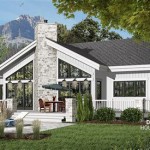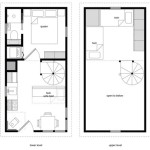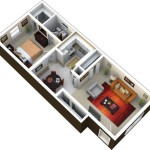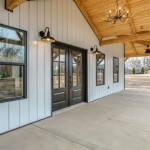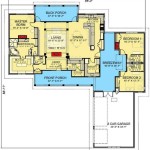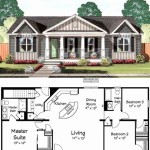A 2 Bedroom House Plan refers to a design blueprint for a residential building featuring two separate bedrooms. These plans are commonly utilized in the construction of modest-sized homes, catering to the needs of small families, couples, or individuals seeking a comfortable and functional living space.
The primary purpose of a 2 Bedroom House Plan is to provide a well-organized and efficient layout for living, sleeping, and other household activities. It typically includes a master bedroom with an attached bathroom, a smaller secondary bedroom, and shared common areas such as a living room, kitchen, dining area, and bathrooms. These plans are often designed to optimize space utilization, ensuring a comfortable and practical living environment.
In the following sections, we will delve into the various elements and considerations involved in designing a 2 Bedroom House Plan. We will explore aspects such as room layout, space planning, architectural styles, and tips for maximizing functionality and comfort in these homes.
When designing a 2 Bedroom House Plan, several important considerations come into play. Here are 9 key points to keep in mind:
- Room Layout
- Space Planning
- Architectural Style
- Master Bedroom Suite
- Secondary Bedroom
- Common Areas
- Storage Solutions
- Natural Lighting
- Outdoor Space
These elements contribute to creating a functional, comfortable, and visually appealing living space in a 2 Bedroom House Plan.
Room Layout
The room layout in a 2 Bedroom House Plan is crucial for ensuring efficient space utilization and a comfortable living environment. Here are some key considerations for room layout:
1. Bedroom Placement: The master bedroom is typically positioned to offer privacy and a sense of separation from the secondary bedroom. It is often placed at the back of the house or on a separate floor to minimize noise disturbance. The secondary bedroom, on the other hand, can be located near the master bedroom or in a different part of the house, depending on the desired level of privacy and proximity.
2. Common Areas: The living room, dining area, and kitchen form the core of the common areas in a 2 Bedroom House Plan. These spaces should be designed to flow seamlessly into one another, creating a sense of openness and spaciousness. The living room should be positioned to receive ample natural light and offer comfortable seating arrangements for relaxation and entertainment.
3. Kitchen Functionality: The kitchen should be designed to maximize functionality and convenience. It should feature an efficient layout with ample counter space, storage cabinets, and modern appliances. The placement of the kitchen in relation to the dining area and living room is also important, ensuring easy access and flow during meal preparation and serving.
4. Bathroom Accessibility: The bathrooms in a 2 Bedroom House Plan should be conveniently accessible from the bedrooms and common areas. The master bathroom is typically designed as an en suite, providing direct access from the master bedroom. The secondary bathroom, on the other hand, can be shared between the secondary bedroom and guests.
Overall, the room layout in a 2 Bedroom House Plan should prioritize functionality, privacy, and a comfortable living experience for the occupants.
Space Planning
Space planning is a critical aspect of designing a functional and comfortable 2 Bedroom House Plan. It involves optimizing the available space to create a well-balanced and efficient layout that meets the needs of the occupants.
- Maximize Natural Light: Natural light plays a vital role in creating a bright and inviting living environment. When planning the layout of a 2 Bedroom House Plan, consider the orientation of the house to take advantage of natural light. Position windows and doors strategically to allow ample sunlight into the living spaces, reducing the need for artificial lighting and creating a more cheerful atmosphere.
- Define Spaces Clearly: While open floor plans are popular, it is essential to define different spaces within the house clearly. Use furniture, area rugs, or dividers to separate the living room, dining area, and kitchen, creating distinct zones for various activities. This helps maintain a sense of order and organization, making the space feel more spacious and functional.
- Create a Flowing Layout: The layout of a 2 Bedroom House Plan should promote a smooth and effortless flow of movement between different areas of the house. Avoid creating dead-end spaces or awkward transitions. Instead, ensure that there is a logical connection between rooms and that traffic can move easily throughout the house without any hindrances.
- Utilize Vertical Space: In a 2 Bedroom House Plan, maximizing vertical space is crucial for creating the illusion of more space. Utilize tall bookshelves, floating shelves, and loft storage to store items and make the most of vertical surfaces. This helps keep the floor space clear, making the rooms feel larger and more organized.
Effective space planning in a 2 Bedroom House Plan ensures that the available space is used wisely, creating a comfortable, functional, and visually appealing living environment.
Architectural Style
The architectural style of a 2 Bedroom House Plan plays a significant role in determining its overall aesthetic appeal and character. Here are four popular architectural styles for 2 Bedroom House Plans:
- Modern: Modern architectural style emphasizes clean lines, geometric shapes, and a minimalist approach. Modern 2 Bedroom House Plans often feature open floor plans, floor-to-ceiling windows, and a focus on natural materials such as wood, stone, and glass. They prioritize functionality and efficiency, creating a sleek and sophisticated living environment.
- Traditional: Traditional architectural style draws inspiration from classic design elements and historical precedents. Traditional 2 Bedroom House Plans typically have symmetrical facades, pitched roofs, and decorative details such as moldings, cornices, and shutters. They offer a sense of warmth and nostalgia, evoking a timeless appeal.
- Contemporary: Contemporary architectural style combines elements from both modern and traditional styles, resulting in a unique and updated look. Contemporary 2 Bedroom House Plans often feature clean lines and open floor plans like modern style, but they may incorporate traditional elements such as pitched roofs or decorative accents. They strike a balance between classic and modern aesthetics, creating a fresh and inviting living space.
- Craftsman: Craftsman architectural style originated in the early 20th century and emphasizes natural materials, handcrafted details, and a warm and inviting atmosphere. Craftsman 2 Bedroom House Plans typically have low-pitched roofs, exposed beams, and inviting porches. They prioritize comfort and livability, creating a cozy and charming living space.
The choice of architectural style for a 2 Bedroom House Plan depends on personal preferences, the surrounding environment, and the desired aesthetic.
Master Bedroom Suite
The master bedroom suite is a central element in a 2 Bedroom House Plan, serving as a private sanctuary for the homeowners. It typically consists of the master bedroom, an en suite bathroom, and often a walk-in closet or dressing area.
Spacious and Tranquil Retreat: The master bedroom should be designed to provide a sense of spaciousness and tranquility. It should be large enough to accommodate a comfortable bed, nightstands, a dresser, and other essential furniture. Large windows or a sliding glass door leading to a private balcony or patio can enhance the feeling of openness and bring in natural light, creating a relaxing and rejuvenating atmosphere.
En Suite Bathroom: The en suite bathroom is an integral part of the master bedroom suite, offering privacy and convenience. It should be designed to be both functional and luxurious. A double vanity with ample storage space, a large shower, and a separate soaking tub are common features in master en suites. High-end finishes, such as marble countertops, heated floors, and elegant lighting fixtures, can create a spa-like experience within the comfort of home.
Walk-In Closet or Dressing Area: A walk-in closet or dressing area provides ample storage space for clothing, shoes, and accessories. It should be well-organized with built-in shelves, drawers, and hanging rods to maximize storage capacity. A vanity or dressing table can also be incorporated into the closet or dressing area, creating a convenient space for getting ready in the morning or preparing for a night out.
Overall, the master bedroom suite in a 2 Bedroom House Plan is designed to provide a private and luxurious retreat for the homeowners, offering a comfortable and functional space to relax, recharge, and prepare for the day ahead.
Secondary Bedroom
The secondary bedroom in a 2 Bedroom House Plan serves as a versatile space that can be adapted to various needs and preferences. Whether it’s intended as a guest room, a child’s room, or a home office, the secondary bedroom should be designed to be comfortable, functional, and inviting.
- Flexible Functionality: The secondary bedroom can be designed to accommodate a variety of functions, depending on the needs of the occupants. It can be furnished as a guest room with a comfortable bed and ample storage space for visitors. Alternatively, it can be transformed into a child’s room with playful decor, built-in storage solutions, and a designated play area. If work-from-home needs arise, the secondary bedroom can be converted into a functional home office, complete with a desk, ergonomic chair, and ample storage for office supplies.
- Natural Light and Ventilation: As with the master bedroom, access to natural light and ventilation is crucial for creating a comfortable and healthy environment in the secondary bedroom. Position windows strategically to allow ample sunlight to enter the room, reducing the need for artificial lighting. Cross-ventilation can be achieved by placing windows or vents on opposite walls, promoting air circulation and maintaining a fresh and airy atmosphere.
- Adequate Storage: Built-in closets, drawers, and shelves provide ample storage space for clothing, bedding, and other belongings in the secondary bedroom. Vertical storage solutions, such as tall bookshelves or hanging organizers, can maximize storage capacity without taking up too much floor space. A dedicated linen closet or under-bed storage can also be incorporated to keep extra linens, blankets, and seasonal items organized and out of sight.
- Privacy and Comfort: If the secondary bedroom is intended to be used as a guest room or a child’s room, it is important to ensure privacy and comfort. Consider adding soundproofing materials to the walls and ceiling to minimize noise disturbance from adjacent rooms. Blackout curtains or blinds can provide darkness and privacy when needed, creating a restful and comfortable sleeping environment.
Overall, the secondary bedroom in a 2 Bedroom House Plan should be designed to be adaptable, functional, and comfortable, catering to the diverse needs of the occupants.
Common Areas
Common areas in a 2 Bedroom House Plan play a crucial role in bringing occupants together and fostering a sense of community. These spaces are designed to be functional, comfortable, and inviting, catering to various activities and needs.
- Living Room:
The living room is the heart of the home, serving as a place for relaxation, entertainment, and socializing. In a 2 Bedroom House Plan, the living room should be designed to be spacious and comfortable, with ample seating arrangements for family and guests. Large windows or a sliding glass door leading to a patio or balcony can create a seamless connection between indoor and outdoor living spaces, enhancing the overall sense of space and brightness.
- Dining Area:
The dining area is where families and friends gather to share meals and create lasting memories. In a 2 Bedroom House Plan, the dining area should be conveniently located near the kitchen for easy serving and cleanup. It should be large enough to accommodate a dining table and chairs comfortably, providing a dedicated space for dining and entertaining.
- Kitchen:
The kitchen is the central hub of the home, where meals are prepared and family gatherings often take place. In a 2 Bedroom House Plan, the kitchen should be designed to be both functional and inviting. It should feature an efficient layout with ample counter space, storage cabinets, and modern appliances. A kitchen island or breakfast bar can provide additional seating and work surface, creating a casual and sociable atmosphere.
- Home Office/Study:
With the increasing prevalence of remote work and the need for dedicated workspaces, many 2 Bedroom House Plans now incorporate a home office or study. This dedicated space provides a quiet and distraction-free environment for work, study, or pursuing hobbies. It should be equipped with a desk, comfortable chair, ample storage, and good lighting to promote productivity and focus.
Overall, the common areas in a 2 Bedroom House Plan are designed to create a comfortable, functional, and inviting living environment for the occupants, fostering a sense of community and providing spaces for relaxation, entertainment, dining, work, and hobbies.
Storage Solutions
In a 2 Bedroom House Plan, maximizing storage space is essential for maintaining a tidy and organized living environment. Here are four key storage solutions to consider:
- Built-In Closets and Wardrobes:
Built-in closets and wardrobes offer ample storage space for clothing, shoes, and accessories. They can be customized to fit the specific dimensions of each bedroom, ensuring optimal space utilization. Sliding doors or bi-fold doors can save space and provide easy access to the closet’s contents.
- Under-Bed Storage:
Under-bed storage is a great way to utilize often-overlooked space. Rolling storage bins or drawers can be placed under the beds in both the master bedroom and secondary bedroom to store seasonal items, extra bedding, or other belongings that are not frequently used.
- Vertical Storage:
Vertical storage solutions, such as tall bookshelves, floating shelves, and hanging organizers, make the most of vertical space. These solutions can be used in common areas like the living room or dining area to store books, display decorative items, or keep frequently used items within reach.
- Multi-Purpose Furniture:
Multi-purpose furniture pieces can provide both style and storage. Ottomans with built-in storage compartments, coffee tables with drawers, and beds with lift-up bases can help keep clutter at bay while maintaining a cohesive and functional living space.
By incorporating these storage solutions into a 2 Bedroom House Plan, homeowners can create a well-organized and clutter-free living environment, ensuring that everything has a designated place and is easily accessible when needed.
Natural Lighting
Natural lighting plays a crucial role in creating a healthy and inviting living environment in a 2 Bedroom House Plan. Here are four key points to consider:
- Maximize Window Placement:
Windows are the primary source of natural light in a house plan. When designing a 2 Bedroom House Plan, architects strategically place windows to allow ample sunlight to enter the living spaces. Large windows or sliding glass doors in the living room and master bedroom can create a bright and airy atmosphere, reducing the need for artificial lighting during the day.
- Consider Orientation:
The orientation of the house on the building lot can significantly impact natural lighting. In the Northern Hemisphere, south-facing windows receive the most direct sunlight throughout the day. By orienting the house accordingly, homeowners can maximize natural light in the main living areas, such as the living room, dining area, and kitchen.
- Utilize Reflective Surfaces:
Reflective surfaces, such as light-colored walls, mirrors, and glossy finishes, can bounce natural light around the room, making spaces feel larger and brighter. In a 2 Bedroom House Plan, incorporating reflective surfaces into the design can enhance the overall sense of spaciousness and well-being.
- Avoid Overhanging Structures:
Overhanging structures, such as eaves or balconies, can block natural light from entering the house. When designing a 2 Bedroom House Plan, architects carefully consider the placement of these structures to minimize their impact on natural lighting. By ensuring that windows are not obstructed, homeowners can enjoy ample sunlight throughout the day.
Incorporating these natural lighting strategies into a 2 Bedroom House Plan creates a bright, inviting, and energy-efficient living environment that enhances the overall quality of life for the occupants.
Outdoor Space
Outdoor space is a valuable asset in any home, and it is especially important in a 2 Bedroom House Plan, where indoor space is often limited. A well-designed outdoor space can provide a place to relax, entertain, and enjoy the fresh air and sunshine. Here are four key elements to consider when designing outdoor space in a 2 Bedroom House Plan:
- Patios and Decks:
Patios and decks are popular outdoor living spaces that extend the living area outdoors. Patios are typically made of concrete or pavers, while decks are made of wood or composite materials. Both patios and decks can be used for a variety of activities, such as dining, entertaining, or simply relaxing. When designing a patio or deck, consider the size, shape, and location carefully to ensure that it meets the needs of the occupants and complements the overall design of the house.
- Landscaping:
Landscaping can transform an outdoor space, adding beauty, privacy, and functionality. When landscaping a 2 Bedroom House Plan, consider using a variety of plants, including trees, shrubs, flowers, and groundcover. Trees can provide shade and privacy, while shrubs and flowers can add color and interest. Groundcover can help to prevent erosion and define planting beds. By carefully selecting and arranging plants, homeowners can create an outdoor space that is both visually appealing and functional.
- Fencing and Privacy:
Fencing and privacy are important considerations for outdoor spaces, especially in densely populated areas. Fencing can be used to define the boundaries of the property, provide privacy from neighbors, and keep pets and children safe. There are many different types of fencing available, including wood, vinyl, metal, and chain link. When choosing a fence, consider the style of the house, the surrounding landscape, and the desired level of privacy.
- Outdoor Lighting:
Outdoor lighting can extend the usability of outdoor space into the evening hours. When designing an outdoor lighting plan, consider the different types of lighting that are available, including ambient lighting, task lighting, and accent lighting. Ambient lighting provides general illumination, while task lighting is used for specific activities, such as grilling or reading. Accent lighting can be used to highlight architectural features or create a dramatic effect. By carefully planning the outdoor lighting, homeowners can create an outdoor space that is both functional and inviting after dark.
By incorporating these elements into the design of a 2 Bedroom House Plan, homeowners can create an outdoor space that is both beautiful and functional, providing a place to relax, entertain, and enjoy the outdoors.










Related Posts

